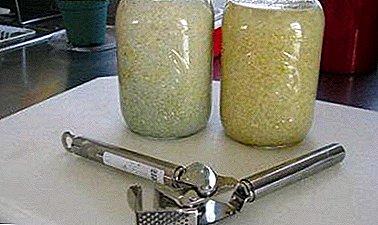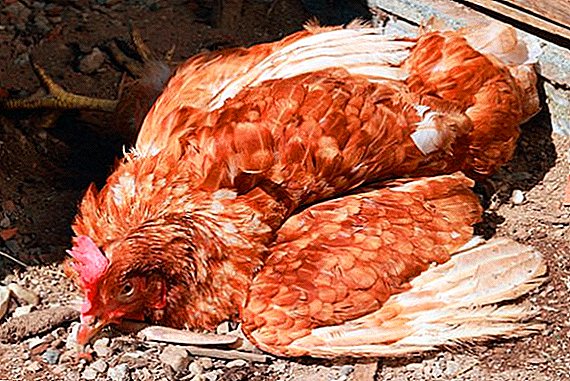 Mass breeding of chickens in farms requires adherence to a set of rules and regulations. Highly productive and healthy birds are the result of daily care for their health, because today there are many diseases with rapid development and a high percentage of mortality. One of them is Gamboro's disease: consider its features and basic methods of control.
Mass breeding of chickens in farms requires adherence to a set of rules and regulations. Highly productive and healthy birds are the result of daily care for their health, because today there are many diseases with rapid development and a high percentage of mortality. One of them is Gamboro's disease: consider its features and basic methods of control.
What is this disease
Gumboro disease, or infectious bursitis, is an acute viral disease of chickens, the first time the appearance of which became known in 1962 in the city of Gamboro (United States of America). Today, it affects livestock not only in America, but also in other countries of Europe and Asia.
Economic damage
For poultry farmers, losses are significant and they are calculated not only by the number of the dead livestock, but this is 10–20% of the total herd. Sometimes lethal outcomes are observed in 50% of the total number of diseased chickens: it all depends on the age, breed and conditions of their housing.
Find out what are the reasons for laying hens and how to cure sneezing, wheezing, coughing in chickens and chickens.
The loss also brings a large percentage of culling carcasses that lose their attractiveness due to multiple hemorrhages and exhaustion.  The disease has many indirect negative factors. Firstly, it greatly weakens the herd, making it susceptible to many other infections, secondly, it significantly reduces the effect of preventive vaccinations, and thirdly, it negatively affects the productivity of the livestock.
The disease has many indirect negative factors. Firstly, it greatly weakens the herd, making it susceptible to many other infections, secondly, it significantly reduces the effect of preventive vaccinations, and thirdly, it negatively affects the productivity of the livestock.
Important! There is still no way to cure infectious bursitis. The most effective method of dealing with the disease is timely vaccination.
Causative agent
The causative agent of the disease enters the body of the bird through the mucous membranes. It is able to withstand temperatures up to + 70 ° C for half an hour, it is resistant to alkalis (pH from 2 to 12) and acids, as well as to lipid solvents. The causative agent of the disease Gamborough may persist in chicken litter for four months. 
Only disinfectants can quickly destroy the virus cells:
- formalin;
- iodine derivatives;
- chloramine.
This virus has no antigens and belongs to reoviruses. For a long time, bursitis virus was classified as adenovirus. For some time after detection of the disease, it was believed that infectious bursitis and infectious bronchitis are caused by a single pathogen.
Only chickens are susceptible to the infectious bursitis virus, although it is believed that the disease also affects sparrows and quails.
Epizootological data
The main risk group is the reproductive farms in which individuals of different ages are kept. The main source of bursitis is virus infected chickens. Most often, the disease has an acute and subacute course, less often bursitis disappears without symptoms.  The virus quickly infects the entire herd. It is noteworthy that Gamborough disease is not observed in young animals up to two weeks of age and adult birds. Even if they are infected artificially, they will remain immune to the virus. Chickens are ill with bursitis from 2 to 15 weeks of age. Chickens between the ages of 3 and 5 weeks are most susceptible to it.
The virus quickly infects the entire herd. It is noteworthy that Gamborough disease is not observed in young animals up to two weeks of age and adult birds. Even if they are infected artificially, they will remain immune to the virus. Chickens are ill with bursitis from 2 to 15 weeks of age. Chickens between the ages of 3 and 5 weeks are most susceptible to it.
Did you know? Araucana - Chicken come from South America which bears blue and green eggs. The reason for this phenomenon is the increased content in the chicken of a special bile pigment that paints the shell.
The combined content of sick and healthy birds, contaminated feed and water, litter, litter are all factors of the spread of the virus. It can also be transmitted mechanically - it is carried by people, other types of birds, insects. 
Clinical signs
Gamborough's disease has an ultra-acute flow pattern. Chicken dies during the week, sometimes even faster. The incubation period of bursitis is from three to fourteen days.
We recommend reading about how to treat coccidiosis in chickens and adult chickens.
Clinical manifestations are similar to coccidiosis:
- diarrhea;
- severe apathy;
- tremor;
- tousledness;
- rejection of feed;
Pathoanatomical dissection of a bird infected with bursitis virus reveals the characteristic signs indicating the cause of death — inflammation and hyperplasia of fabrication bursa, abundant hemorrhages in muscle tissue, skin, and nephritis.  Such signs allow a clear diagnosis.
Such signs allow a clear diagnosis.
Important! Chickens who have fallen from Gamboro’s disease die in their characteristic posture, with their legs and neck stretched out.
Pathogenesis
The disease is characterized by rapid spread: its pathogen, orally ingested, after five hours reaches the lymphoid cells of the intestine. Rapid dissemination of the disease is achieved by the penetration of these cells into all circulating systems.
After 11 hours, the virus infects the factory bursa. Thus, two days later, infectious bursitis affects all organs. The main place of virus concentration is the fabrication bursa: it can stay there for up to two weeks.
The defeat of the lymphoid tissue leads to a pronounced immunosuppressive effect. The number of lymphocytes is sharply reduced, almost complete suppression of immunity is observed.  In general, immunity weakened by the Gamboro disease virus leads to an increase in the incidence of birds with viral hepatitis, salmonellosis, gangrenous dermatitis and coccidiosis.
In general, immunity weakened by the Gamboro disease virus leads to an increase in the incidence of birds with viral hepatitis, salmonellosis, gangrenous dermatitis and coccidiosis.
Diagnostics
Clinical and pathological features allow you to accurately diagnose the typical form of the disease. To identify the atypical course of the disease or to establish it in its early stages, a laboratory study based on the isolation and identification of the virus allows.
Familiarize yourself with the symptoms and methods of treating chicken diseases such as aspergillosis, salmonellosis, infectious laryngotracheitis, avian flu, tuberculosis, mycoplasmosis, egg-laydown syndrome, conjunctivitis.
To eliminate bursitis in the differential diagnosis, it is necessary to make sure that the chickens are not sick:
- infectious bronchitis;
- Marek and Newcastle diseases;
- lymphoid leukemia;
- poisoning with sulfonamides;
- fatty toxicosis.

Treatment
Due to the fact that in the body of the sick hens, immunity to Gumboro disease is formed, a large number of live vaccines with a high degree of immunogenicity have been created. The most common vaccines are: "Gumbo-Waks" (Italy), "LZD-228" (France), "Nobilis" (Holland).
Did you know? The hen can be put into a state of hypnosis, if you gently press her head to the ground and draw a straight line with a bird's beak with chalk.
Daily chicks are vaccinated by feeding or intraocularly; young animals over three months old are intramuscularly. Antibodies from vaccinated individuals in high shooting ranges are transmitted to chickens and protect them during the first month of life. 
Prevention
To avoid the disease, you must:
- provide the bird a full diet;
We advise you to read about how and how much to feed domestic chickens, what are the types of feed for chickens, how to prepare a mash for laying hens.
- timely carry out cleaning and disinfection;
- contain birds of different ages in isolation;
- staff the house with individuals of the same age;
- separately incubate the eggs of own production and imported;
- place daily young stock, brought from other farms, separately from the main herd;
- observe the terms of preventive vaccination;
- to ensure the protection of the herd from the introduction of the infection: purchase eggs and day-old young growth only from farms free from infectious bursitis;
- strictly observe zootechnical and veterinary requirements for the maintenance and feeding of birds.
 Compliance with preventive measures and careful attention to the products purchased for incubation and young animals can significantly reduce the risk of infection of birds with infectious bursitis. In the event that this did happen, the sick individuals must be destroyed.
Compliance with preventive measures and careful attention to the products purchased for incubation and young animals can significantly reduce the risk of infection of birds with infectious bursitis. In the event that this did happen, the sick individuals must be destroyed.Reviews from the network














